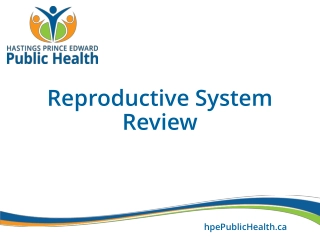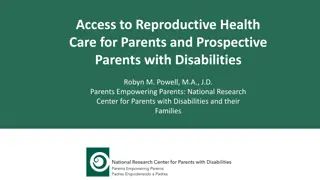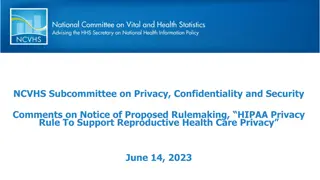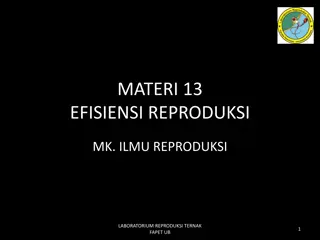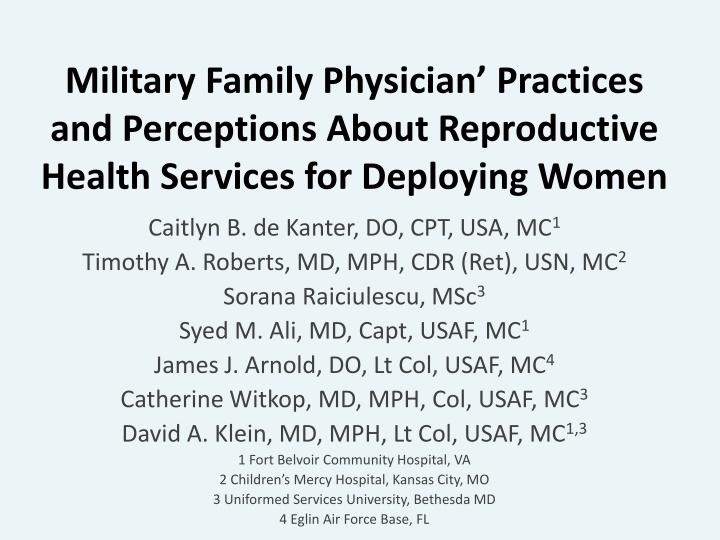
Military Family Physician Practices & Perceptions on Reproductive Health Services for Deploying Women
Explore the insights from military family physicians regarding reproductive health services for deploying women in the armed forces. Understand the challenges, practices, and perceptions shaping the care provided to active duty women.
Download Presentation

Please find below an Image/Link to download the presentation.
The content on the website is provided AS IS for your information and personal use only. It may not be sold, licensed, or shared on other websites without obtaining consent from the author. If you encounter any issues during the download, it is possible that the publisher has removed the file from their server.
You are allowed to download the files provided on this website for personal or commercial use, subject to the condition that they are used lawfully. All files are the property of their respective owners.
The content on the website is provided AS IS for your information and personal use only. It may not be sold, licensed, or shared on other websites without obtaining consent from the author.
E N D
Presentation Transcript
Military Family Physician Practices and Perceptions About Reproductive Health Services for Deploying Women Caitlyn B. de Kanter, DO, CPT, USA, MC1 Timothy A. Roberts, MD, MPH, CDR (Ret), USN, MC2 Sorana Raiciulescu, MSc3 Syed M. Ali, MD, Capt, USAF, MC1 James J. Arnold, DO, Lt Col, USAF, MC4 Catherine Witkop, MD, MPH, Col, USAF, MC3 David A. Klein, MD, MPH, Lt Col, USAF, MC1,3 1 Fort Belvoir Community Hospital, VA 2 Children s Mercy Hospital, Kansas City, MO 3 Uniformed Services University, Bethesda MD 4 Eglin Air Force Base, FL
Disclosures Conflict of Interest: None Financial Support: None Disclaimer: The views expressed are those of the authors and do not reflect the those of the Department of Defense IRB Approval: Fort Belvoir Community Hospital, April 24, 2018, IRB#1 (Reference 902975)
Background Active duty women need specific preventive services Gynecologic care Sexual and Reproductive health 16% Women in the military Demographics 2016
Military Significance Threats to the health of active duty women impact the mission and lethality of the force Readiness, health, and financial costs Among all pregnancies to active duty women, 50- 65% are unintended Up to 10% of women become pregnant while deployed 2% medical evacuations from deployment are for unintended pregnancies Grindlay; Goyal; Braun; Lindbery; Heitmann
Background Barriers in deployment healthcare 60% report no contraceptive counseling Availability of medication refills Stigma associated with seeking reproductive and sexual health care Confidentiality Grindley; Nielsen; Manski
Purpose Assess sexual and reproductive health counseling practices and perceptions among family physicians caring for active duty women To determine if military family physicians are positioned to provide quality services to deployed and deploying women
Methods USAFP 2018 Omnibus live survey responses through PollEverywhere and online responses for those not in attendance 568 clinicians surveyed, 300 (52.8%) responded 207 included
Statistical Analysis Descriptive Means, standard deviations, ranges for continuous variables Counts and percents for categorical variables Chi-Square and Odds Ratio to determine and quantify associations Fisher s ExactTest for small cell counts
Demographics of Surveyed Physicians Number (%) Number (%) Sex Level of Training Male 119 (58.3%) FM Resident 35 (18.3%) Female 85 (41.7%) Early Career Staff 82 (42.9%) Mid-Career or Senior Staff 74 (38.7%) Race Caucasian 175 (85.4%) Prior Military Deployment Black 11 (5.4%) Yes 113 (55.12%) Asian/Pacific Islander 12 (5.9%) No 92 (44.88%) Other/choose not to respond 7 (3.4%)
Physician Perception of Reproductive Health Topics in the Deployed Setting 80% 70% 60% 50% 73% 40% 30% 50% 46% 41% 20% 30% 29% 22% 10% 5% 4% 0% Emergency Contraception is Available Condoms Available Menstruation has readiness impact Agree Disagree Unsure
Physician Perception of Reproductive Health Topics in the Deployed Setting 100% 100% 90% 90% OR 4.8, 95% CI 2.23-11.14 80% 80% 70% 70% OR 25.7, 95% CI 11.4-57.8 60% 60% 50% 50% 88% 61% 40% 40% 72% 87% 30% 30% 32% 20% 20% 20% 10% 10% 13% 8% 9% 7% 0% 0% Prior Deployment No Deployment Prior Deployment No Deployment Agree Unsure Disagree Agree Unsure Disagree Emergency Contraception is Available in Deployed Environment Condoms are Available in Deployed Environment
Menstruation Has Readiness Impact on Deployed Women 60% OR 3.2, 95% CI 1.62-6.37 50% 40% 51% 30% 43% 31% 30% 26% 20% 19% 10% 0% Female Physicians Male Physicians Agree Unsure Disagree
Among physicians who have deployed, challenges to providing care Access factors 21% 54% Patient factors (3%) 22% Access and patient factors Patient Factors: Perceived stigma, fear violating policy, confidentiality concerns Access Factors: inability to provide desired method No challenges Challenges
Contraception discussions at readiness visits Not involved 36% 17% Yes 81% Yes 52% Higher Priority 2% Ethical/ Religious No N=132
Long Acting Reversible Contraception Intrauterine or implantable contraceptives Most effective contraception options Simple for end-user May regulate menses
Timeline for LARC Placement Implant IUD Would not place or refer 7% Would not place or refer 9% Same Day 18% Same Day 16% <2 weeks 50% <2 weeks 50% 2-4 weeks 23% 2-4 weeks 20% >4 weeks 4% >4 weeks 3%
Timeline of LARCs relation to contraceptive counseling Physicians who could offer a subdermal implant within 2 weeks were more likely to discuss contraception than those who could not (87.0% versus 64.7%, p = 0.005)
Contraception Offerings for Deploying Women Pills 100% OR 3.4 95% CI 1.44-8.48 90% 80% 91% 70% 75% 60% 50% 40% 30% 20% 25% 10% 9% 0% Previous Deployment No Deployment Yes No
Contraception Offerings for Deploying Women Intrauterine Method Implant 100% 100% 90% 90% 80% 80% 91% 70% 70% 86% 86% 87% 60% 60% 50% 50% 40% 40% 30% 30% 20% 20% 10% 10% 14% 14% 13% 9% 0% 0% Previous Deployment No Deployment Previous Deployment No Deployment Yes No Yes No
Contraception not offered for deploying women 15.8% of physicians would not offer oral contraceptive 12.3% would not offer intrauterine methods 14.3% would not offer subdermal implants
Prescribing Emergency Contraception Religious or ethical 15% Still Refer No Yes Training or education 27% 5% 73% Both 2.5% 4.5% Do not prescribe OR refer (religious/ethical) 73% don t know if emergency contraception is available during deployment!
Summary and Implications Differing knowledge and beliefs could create disparities Supports standardized sexual and reproductive health counseling at readiness visits Supports downrange resourcing for reproductive health services(trained clinicians; availability of condoms, emergency contraceptives, etc.) Previously deployed physicians more confident in deployment knowledge and likely to offer oral contraceptives but not long-acting methods
Strengths Captures approximately 10% of active duty family physicians and family medicine residents serving, including many teachers of family medicine Provides novel data on clinicians perceptions
Limitations Conference attendants likely over represent academically oriented clinicians Able to determine associations, not causation Recall bias Non-family medicine trained clinicians who conduct readiness visits (GMO, PA/NP, flight surgeons) are not sampled
Further Study Evidence-based strategies to provide high quality care to improve readiness and health of service members Disparities in services provided based on clinician education, training tools, appointment length, or diversity of provider experience Servicemember s knowledge on confidentiality & policies Effect of appropriately timed LARC provision on health and readiness outcomes for deployed/deploying women
References 2016 Demographics: Profile of the Military Community. Available at http://download.militaryonesource.mil/12038/MOS/Reports/2016-Demographics- Report.pdf. Accessed July 6, 2018. Grindlay K, Grossman D. Unintended pregnancy among active-duty women in the United States military, 2011. Contraception. 2015;92(6):589-595. Goyal V, Borrero S, Schwarz EB. Unintended pregnancy and contraception among active-duty servicewomen and veterans. Am J Obstet Gynecol. 2012;206(6):463-469. Braun LA, Kennedy HP, Womack JA, Wilson C: Integrative Literature Review: U.S. Military Women s Genitourinary and Reproductive Health. Mil Med 2016;181(1):35-49. Grindlay K, Grossman D. Contraception access and use among U.S. servicewomen during deployment. Contraception. 2013;87(2):162-169. Nielsen PE, Murphy CS, Schulz J, et al. Female soldiers' gynecologic healthcare in Operation Iraqi Freedom: a survey of camps with echelon three facilities. Mil Med. 2009;174(11):1172- 1176. Heitmann RJ, Batig AL, Levy G, et al. Unintended pregnancy in the military health care system: who is really at risk? Mil Med. 2016;181(10):1370-1374.

